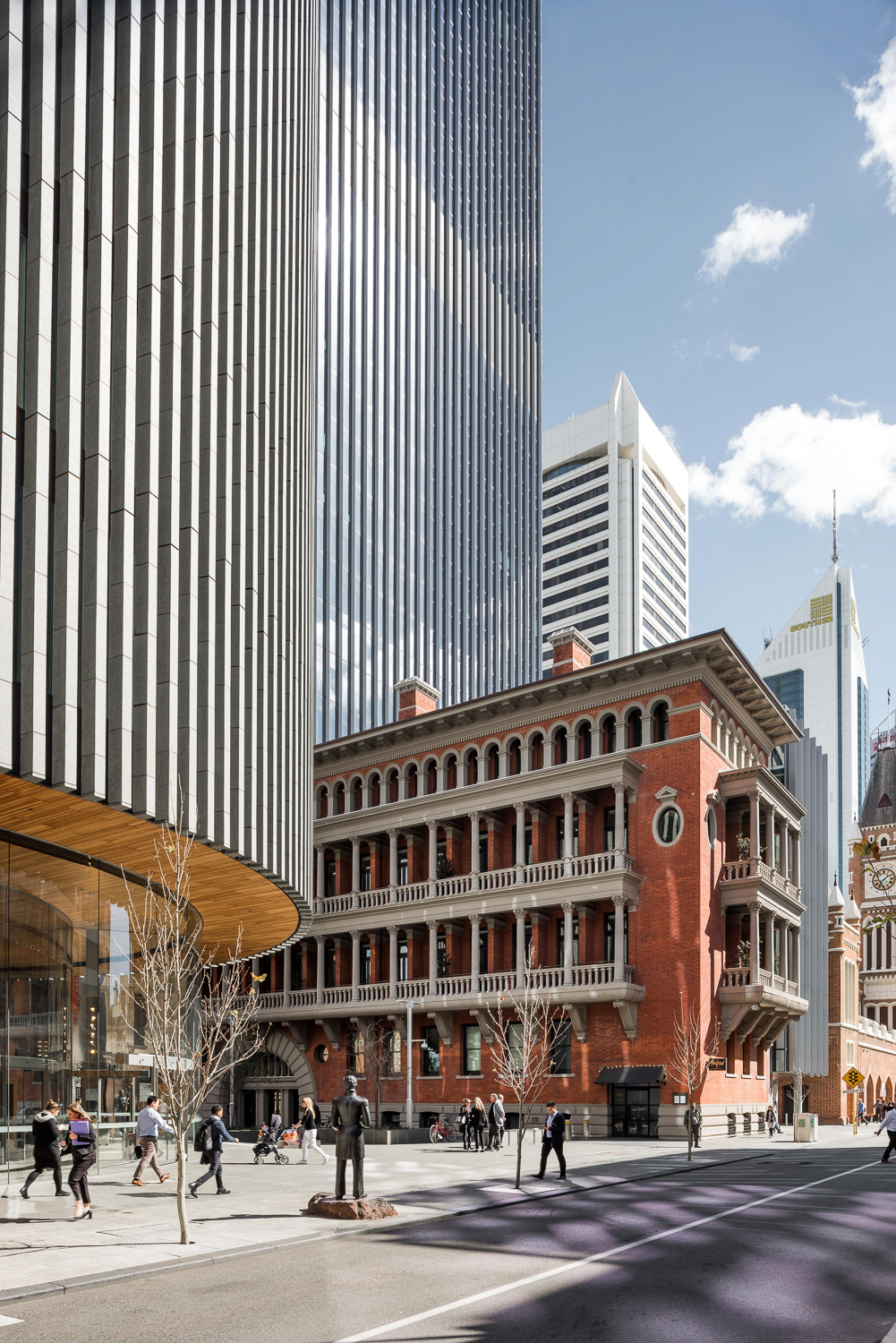connecting our city to the matagarup bridge and optus stadium
Perth’s Historic Heart is the link between our city and the new Matagarup Bridge and Optus Stadium. Enjoy a self-guided 30 minute walk from Cathedral Square to the stadium, heading east along Hay Street - or a 40 minute walk from Yagan Square heading east along Murray Street and then Hay Street.
Our Stadium Walk is available on our Historic Heart of Perth Web App - free to download via link below.
1. Point Zero
1 Cathedral Avenue, Perth
Start your walk to Matagarup Bridge and Optus Stadium at 'Point Zero' (marked as a heart on our map).
Situated on the south-east corner of the Old Treasury building on the corner of Cathedral Avenue and St Georges Terrace, this is the marker from which all distances to and from Perth are measured, and represents the centre point and civic heart of the city.
The marker was chosen during the building’s life as the state’s first post office. An understated plaque marking the adoption was laid in 1975.
2. Ascalon (2011)
1 Cathedral Avenue, Perth
In Cathedral Square you can't miss 'Ascalon' - a sculpture by artists Marcus Canning and Christian de Vietri.
Ascalon, the striking, billowing white sculpture that stands before St George’s Cathedral is an abstract interpretation of the legend of St George and the dragon. The sculpture depicts the triumph of good over evil, with the sculpture’s angled pole and white billow representing St George’s lance, cloak and steed, and its black base reminiscent of the defeated body of the dragon.
The name of the sculpture is taken from the name of St George’s lance in medieval romances – itself a derision of the city of Ashkelon in Israel – the sculpture is a fittingly commanding statement at the forecourt of the cathedral.
3. State Buildings 1874
Cathedral Avenue, Perth
The western side of Cathedral Square is bound by the magnificent State Buildings.
Starting with just three small buildings to run all of State Government business, various additions were made to the site on the corner of Barrack Street and St Georges Terrace. It was not until 1890 that the complex started to take on its more familiar look, when architect George Temple Poole drew up plans for a new General Post Office in the French Second Empire Style. More buildings, and sometimes additional storeys were added to existing buildings, and in 1904 the facades of the older buildings were remodelled, giving the State Buildings their much-admired elevations which remain today.
Over their 140-year history, the State Buildings have been used as Public Offices, a Police Court and cellblock, Treasury, Survey Department, GPO, Immigration Offices, office of the Premier and Cabinet, Lands Department and Titles Building.
During the last half of the 20th century, various government departments left the building for new accommodation. After this, the site was empty for nearly two decades and a variety of proposals for its redevelopment never saw the light of day. However, it now has a new lease of life with a variety of upmarket bars, cafes and retail spaces, including the luxury COMO The Treasury Hotel.
4. Criterion Hotel 1937
560 Hay Street, Perth
As you walk east along Hay Street, look out for the Art Deco Criterion Hotel on the northern side of the road.
Art Deco was a popular architectural style throughout Australia after the Depression, when building activity increased significantly from 1936. Hotels inspired by Art Deco architecture included the centrally located Adelphi Hotel (demolished in the 1970s) and the Bohemia Hotel (demolished in 1980s), along with the Raffles
The Criterion Hotel is also significant as the site of the oldest continuously licensed public house in Perth, with a “pub” operating on the site of the Criterion Hotel since at least 1848.
5. Pier Street Precinct
Pier Street, Perth
At the intersection of Hay and Pier Streets, look north to view Pier Street's interesting collection of buildings and pleasant streetscape.
The precinct’s unique appearance is due to the amalgamation of diverse period buildings; the Salvation Army Fortress and Federation period commercial buildings, the 1960s Railton Temperance Hotel and the later twentieth century Sebel Perth Hotel.
The street is home to several retailers, including Australia’s longest standing independent record store, Dada’s Records. The iconic store is renowned for having the largest selection of new vinyl in the Southern Hemisphere.
For further information on Pier Street see Historic Heart's 'Architecture Walk' page.
6. St George's Theatre facade 1879
500 Hay Street, Perth.
At 500 Hay Street is the St George's Theatre facade - the site of the first dedicated theatre building in Perth. Demolished in the 1980s to make way for the District Court, today only the portico remains.
7. Hibernian Place Muse
480 Hay Street, Perth
At 480 Hay Street, renowned street artist Rone has painted a women’s face on a wall within ‘Hibernian Place’.
Geelong-born Rone is internationally renowned for his larger-than-life female muse paintings, often on a raw concrete canvas. He has painted throughout the US, Europe and Asia. “I am very happy with the end result,” Rone, 37, said. “The challenge for me as an artist is to create something beautiful from a raw, unfinished surface. I hope that’s what I achieved.”
Hibernian Place is a new precinct in the Historic Heart which is home to a hotel, and a range of bars, cafes and restaurants
8. St Mary's Cathedral
Victoria Avenue, Perth.
At the intersection of Hay Street and Victoria Avenue look north to see St Mary’s Cathedral. Few building projects in Perth have taken as long as the Cathedral. Constructed in phases, the first phase was completed in 1865, a major addition was made in the 1920s, but the Cathedral wasn’t completed until 2009.
For further information on St Mary's Cathedral see Historic Heart's 'Architecture Walk' page.
9. Grosvenor Hotel
339 Hay Street, Perth.
Built in 1886 as a private home, it was granted a hotel licence later that same year to Robert Stroud. The Grosvenor has been in service as a pub ever since, and this makes it one of the oldest pubs still operating in Perth today
10. The Perth Mint
Cnr Hay and Hill Streets
Established in 1899, The Perth Mint is Australia’s oldest operating mint. It gives visitors the rare opportunity to discover the wonder of gold through its combination of attractions, exhibitions and live demonstrations. View the largest gold coin in the world valued at more than $50 million, and watch a gold pouring demonstration in an original melting house.
For further details on The Perth Mint see Historic Heart's 'Small Museums' page.
11. Queen's Gardens
Cnr Hay and Plain Streets, East Perth
Now a 3.3ha park, the site was initially used for recreation, including horse racing, and then later used as a clay pit and brickworks. Bricks produced from the site between 1860 and 1890 feature in many of Perth’s prominent buildings constructed at that time.
12. WACA Grounds and WACA Museum
Nelson Crescent, East Perth
Experience the rich heritage and history of the Western Australian Cricket Association and the WACA Ground through the WACA Museum displays and ground tours which exist to inspire all to enjoy and play the great game of cricket.
For further details on the WACA see Historic Heart's 'Small Museums' page.
13. Matagarup Bridge
Officially opened in July 2018, the “Matagarup Bridge” linking the city to the Optus Stadium is named after the Whadjuk name for the area around Heirisson Island. It means a place where the river is only leg deep, allowing it to be crossed.
14. Chevron Gardens
at Optus Stadium
Developed with input from the Whadjuk community, this vast space is inspired by the Noongar six seasons. It sprawls across 2.6 hectares of transformed parkland, with plenty of nature play elements for kids.
15. Optus Stadium
Optus Stadium has capacity of over 60,000 people, making it the third-largest stadium in Australia. The stadium’s innovative design is intended to feel distinctly local, with architecture and landscaping that reflect the state’s proud sporting, cultural and Aboriginal heritage.
Photographs by Dion Robeson and Kelly Pilgrim-Byrne.


















